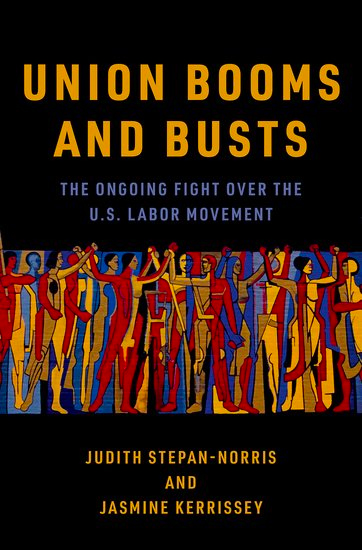
Union Booms and Busts: The Ongoing Fight Over the U.S. Labor Movement
 Headlines about worker strikes spanning industries from healthcare to transportation
to entertainment are a constant in today’s news cycle. While this new wave of labor activity constitutes a significant increase following
decades of decline, it’s far from unprecedented, says UCI sociologist Judith Stepan-Norris.
Her new book, Union Booms and Busts: The Ongoing Fight Over the U.S. Labor Movement (Oxford University Press), coauthored with Jasmine Kerrissey ’12 UCI Ph.D. and current
sociology associate professor and Labor Center director at the University of Massachusetts
Amherst, takes a 115-year look at labor dynamics, finding that key economic, political
and societal conditions, along with innovative strategies adopted by workers/labor
leaders and employers/employers’ organizations, can make or break unionization efforts.
Below, Stepan-Norris expands on the historical and contemporary labor landscape and
what we might expect to see going forward.
Headlines about worker strikes spanning industries from healthcare to transportation
to entertainment are a constant in today’s news cycle. While this new wave of labor activity constitutes a significant increase following
decades of decline, it’s far from unprecedented, says UCI sociologist Judith Stepan-Norris.
Her new book, Union Booms and Busts: The Ongoing Fight Over the U.S. Labor Movement (Oxford University Press), coauthored with Jasmine Kerrissey ’12 UCI Ph.D. and current
sociology associate professor and Labor Center director at the University of Massachusetts
Amherst, takes a 115-year look at labor dynamics, finding that key economic, political
and societal conditions, along with innovative strategies adopted by workers/labor
leaders and employers/employers’ organizations, can make or break unionization efforts.
Below, Stepan-Norris expands on the historical and contemporary labor landscape and
what we might expect to see going forward.
Why does there appear to be a sharp uptick in labor actions today vs the past few decades?
The number of workers on strike during the first eight months of 2023 (more than 323,000) along with pending strikes (like the possible 150,000 autoworkers strike in September) create a new situation--a crescendo of labor actions--following a relative lull in strikes and long-term union decline.
Strikes, like union density (the proportion of workers who belong to a union), fluctuate along with economic, legal, and political conditions. Workers’, union leaders’ and employers’ actions also directly and indirectly impact the level of strike activity. Beginning in the early 1980s, conditions deteriorated for worker action, leading to more unsuccessful strikes and even reversals of former wage and benefits gains. Overall strike and union decline followed. During the current period, the level of strike activity has been lower than we’ve seen in any other period. Onlookers and those affected by strikes have become accustomed to this low level of strike activity, and this makes the recent increase seem larger than it is. This new wave constitutes a significant change following decades of decline, but it’s far from unprecedented.
Your book emphasizes the role of historical developments, economic factors, political dynamics, and legal contexts in shaping the trajectory of unions and employers across more than a century. Could you delve deeper into how these factors interacted to influence the successes and failures of union organizing and employer strategies over different decades?
We look at three general periods of labor relations. During the unregulated period (1900-1934), Congress failed to pass laws to enable union organizing and the Courts interpreted what laws they did pass (like the Sherman Anti-Trust Act of 1890) in ways that worked against unions. Employers oftentimes used violent anti-union measures to keep unions at bay. Still, due to their indispensability to the production process, skilled workers were able to organize and win union representation in several industries. During the Regulated Period (1935-1979), New Deal legislation gave most workers the right to strike and to organize into unions; Congressional hearings (La Follette) began to scrutinize employer anti-union actions and the National Labor Relations Act (NLRA) placed sanctions on them. Worker solidarity and mass strikes, along with new union industrial organizing strategies allowed semi- and unskilled workers to organize. The Taft-Hartley Act of 1947 (pushed by employers) established employers’ rights in labor relations and a route to union decertification. Laws allowing public workers to organize came later, in the 1960s and afterwards. Unions rose to their peak density during the 1950s. In the Dis-regulated period (1980-2015), cumulative court decisions deteriorated workers’ benefits under the NLRA, strike replacements gained rights (to continue working in their jobs after strikes were settled and to vote in union elections). Right-to-work laws passed in half of all states. Employers again increased their anti-union efforts, but this time with more subtle measures. The fate of women and workers of color were intertwined with these dynamics; their integration into the labor movement progressed throughout the century.
One of the focal points of your book is the exploration of workers' and their unions' actions, including strikes, elections, and organizing strategies. Could you share some specific examples from your research that highlight the ways in which workers effectively used these tactics to gain power and influence throughout the history of unionization?
Forming a union and winning a first contract usually entail strikes (or the threat of strikes). But at any given time, some workers are positioned for successful strikes while others are not. In the unregulated period, skilled workers, workers with timing advantages (e.g., workers whose labor must be performed within a particular timeframe), and those with spatial advantages (e.g., those who were more difficult to replace due to geographic isolation) were successful in organizing into unions, mostly after costly strikes. The dominant union—American Federation of Labor (AFL)--organized mostly skilled workers, who were mainly white and male, and some unions discriminated against women and people of certain races. Semi- and unskilled workers were less successful in organizing during this period. During the regulated period, semi- and unskilled workers used newfound solidarity coming out of the Great Depression and the Unemployed workers movement and utilized a new and dynamic form of strike, called the sit-down strike. Here, workers locked themselves in their workplaces and sat down at their workstations for the duration of the strike; this prevented replacement workers from coming in and continuing production. Sit-down strikes were wildly successful and created momentum for the newly established Congress of Industrial Organizations (CIO). To its benefit, the CIO also made use of the NLRB union election procedures. Although they were at first opposed, AFL unions ended up following suit and began to include semi- and unskilled workers into their unions and to use the NLRB procedures. In the dis-regulated period, strikes began to be less successful, and as a result, less common. Same for NLRB elections. Strikes, union elections, and eventually union organizing declined, with the resulting long-term decline in union density.
On the flip side, your book also discusses the tactics employed by employers to disrupt union organizing, such as legal maneuvers, workforce-based strategies, and exploiting race and gender divisions. Can you elaborate on how these tactics played out in different contexts and eras, and how they impacted the overall landscape of labor unions?
During the unregulated period, employers countered by hiring detectives and spies, firing workers suspected of union organizing, and establishing employers’ organizations (like the National Association of Manufacturers (NAM)). They also frequently used workers of color in divisive roles, such as strike replacements. During the regulated period, employers were held in check by the NLRA. Nevertheless, they planned for new legislation that would enhance their rights in labor relations. These efforts culminated in the passage of the Taft-Hartley Act of 1947, which greatly enhanced their power during union elections. They also began to move some of their facilities to the U.S. South and abroad to avoid unions. During the dis-regulated period, employers adopted more subtle forms of anti-unionism: they hired anti-union consulting firms, double-breasted, increased contingent work, increased the pace of plant relocation and mass layoffs.
The relationship between unions, employers, and the broader societal context is complex. Based on your historical perspective, what insights from your research resonate with the motivations, challenges, and potential outcomes of today’s contemporary labor movements? Are there any parallels or lessons from history that you believe are particularly relevant to understanding current activity and what we might expect going forward?
We've seen again and again that workers want better compensation and working conditions. This is especially true now, with recent high inflation and the overall growth of inequality that began in the 1980s. When favorable conditions lead workers to believe they can win, they push hard. But employers have always fought workers’ collective efforts-- and we should expect that in the future also. Today workers have an opening--the advantage of favorable economic and political conditions, along with positive public opinion, which is at an all-time high. Labor laws, which for decades have not supported unionization, are crucial because they set the stage for what workers and employers may and may not do. When laws favor workers, they have a chance to convince their fellow workers of the benefits of unionization. When laws constrain union organizers’ communications and actions while they enhance employers’ ability to permanently replace striking workers and to extensively stall collective bargaining, unions are severely disadvantaged. But very recently, the NLRB released new pro-worker rulings (Cemex decision), which will make union organizing much easier. Workers have already begun to ramp up their union action and some union leaders have led the charge. If workers and their leaders creatively take advantage of this new opportunity by increasing their organizing efforts in all areas, we may experience a boom of unionization like that of the 1930s and 40s.


